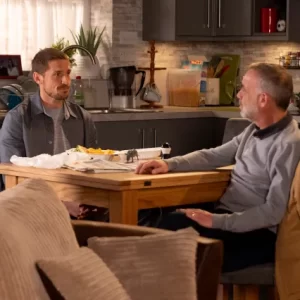In an upcoming and dramatic twist on Coronation Street, viewers are set to witness a shocking event involving young Hope Stape, who is
portrayed by the talented actress Isabella Flanagan.
The storyline will center around Hope’s troubling behavior as she takes drastic and dangerous actions that will have profound implications for
her family and the entire community.
In an alarming turn of events, Hope is discovered to have set fire to her family’s living room, a decision that not only puts her own life at risk but also endangers those around her.
This incident is more than just a dramatic plot point; it reflects deeper issues surrounding Hope’s character and her psychological well-being.
Throughout her time on Coronation Street, Hope has faced numerous challenges, including the impact of her father’s criminal activities and her struggles with feelings of isolation and anger. The fire she sets is symbolic of the internal turmoil she experiences—a desperate cry for help from a child who feels misunderstood and neglected. Viewers may find themselves questioning the factors that lead to such a drastic act, prompting discussions about mental health, emotional support, and the importance of addressing children’s psychological needs.
Hope’s character has been through a great deal, and the fire incident can be seen as a culmination of her unresolved emotions and trauma. After losing her father, John Stape, who was involved in various nefarious activities that ultimately led to his downfall, Hope has carried the weight of his legacy on her small shoulders. This burden has manifested in erratic behaviors and emotional outbursts, which the show has explored over time. By setting the living room ablaze, Hope might be acting out of frustration, fear, or a desire to regain some sense of control in her chaotic life.
As the fire engulfs the living room, it will undoubtedly create a frantic situation that places multiple characters in danger. The drama of the fire will likely escalate quickly, prompting other residents of Weatherfield to react and come to the aid of the situation. The response from her family and neighbors will be critical in shaping the narrative, as it raises important questions about community, responsibility, and the ways in which people come together in times of crisis. How will Hope’s mother, Fiz, respond to her daughter’s alarming actions? What role will other characters play in either supporting or blaming Hope for the chaos that ensues?
The consequences of Hope’s actions will ripple throughout the community, affecting her relationships with those around her. Friends and family members will need to grapple with the fear and confusion that arise from the incident. Trust and communication will be put to the test as those closest to her try to understand what motivated her to take such a reckless step. This situation has the potential to foster important dialogues about how to recognize signs of distress in children and how families can better communicate and support each other during difficult times.
Moreover, the narrative surrounding the fire will serve as a platform for character development, particularly for Hope and her mother. As they navigate the fallout from the incident, both characters will be faced with the challenge of addressing the underlying issues that led to this dangerous behavior. Hope may require professional help, and her journey toward healing and understanding will likely form a core aspect of the storyline. As viewers watch this unfold, they may find themselves rooting for Hope to find her way back from the brink, ultimately leading to moments of growth and redemption.
In addition to Hope’s personal struggles, the fire incident will also have significant implications for the wider community. The aftermath of the blaze will bring together various characters, each responding to the crisis in their unique ways. Some may rally to support Hope and her family, while others may express anger or blame, leading to potential conflicts that could ripple through the neighborhood. This community response will highlight the interconnectedness of life in Weatherfield, illustrating how one individual’s actions can have far-reaching consequences.
Coronation Street has a long history of tackling sensitive issues with care and realism, and this storyline promises to be no exception. By addressing Hope’s disturbing behavior and the fire incident, the show is poised to engage viewers in meaningful conversations about the complexities of childhood trauma, the importance of mental health, and the ways in which families can work together to overcome adversity.
As the storyline develops, fans can expect emotional scenes, powerful performances, and a deep exploration of the themes surrounding family, support, and resilience. The fire in the living room will serve as both a literal and metaphorical catalyst for change in Hope’s life, compelling her and those around her to confront the challenges they face and to seek understanding and healing. In the end, this gripping narrative arc promises to not only entertain but also enlighten audiences, shedding light on the often-unspoken struggles that many families endure in silence. Through Hope’s journey, Coronation Street continues to reaffirm its commitment to portraying the realities of life in a way that resonates with viewers on a personal level.





